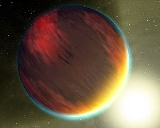
Hot Jupiter
Overview
Extrasolar planet
An extrasolar planet, or exoplanet, is a planet outside the Solar System. A total of such planets have been identified as of . It is now known that a substantial fraction of stars have planets, including perhaps half of all Sun-like stars...
whose mass is close to or exceeds that of Jupiter
Jupiter
Jupiter is the fifth planet from the Sun and the largest planet within the Solar System. It is a gas giant with mass one-thousandth that of the Sun but is two and a half times the mass of all the other planets in our Solar System combined. Jupiter is classified as a gas giant along with Saturn,...
. While Jupiter orbits its parent star (the Sun
Sun
The Sun is the star at the center of the Solar System. It is almost perfectly spherical and consists of hot plasma interwoven with magnetic fields...
) at 5.2 AU, the planets referred to as hot Jupiters orbit
Orbit
In physics, an orbit is the gravitationally curved path of an object around a point in space, for example the orbit of a planet around the center of a star system, such as the Solar System...
between approximately 0.015 AU of their parent stars.
One of the most well-known hot Jupiters is 51 Pegasi b
51 Pegasi b
51 Pegasi b , sometimes though unofficially named Bellerophon, is an extrasolar planet approximately 50 light-years away in the constellation of Pegasus...
, nicknamed Bellerophon. Discovered in 1995, it was the first extrasolar planet found orbiting a Sun-like star
Star
A star is a massive, luminous sphere of plasma held together by gravity. At the end of its lifetime, a star can also contain a proportion of degenerate matter. The nearest star to Earth is the Sun, which is the source of most of the energy on Earth...
.
Hot Jupiters have some common characteristics:
- They have a much greater chance of transitingAstronomical transitThe term transit or astronomical transit has three meanings in astronomy:* A transit is the astronomical event that occurs when one celestial body appears to move across the face of another celestial body, hiding a small part of it, as seen by an observer at some particular vantage point...
their star as seen from a farther outlying point than planets of the same mass in larger orbits.
Discussions

